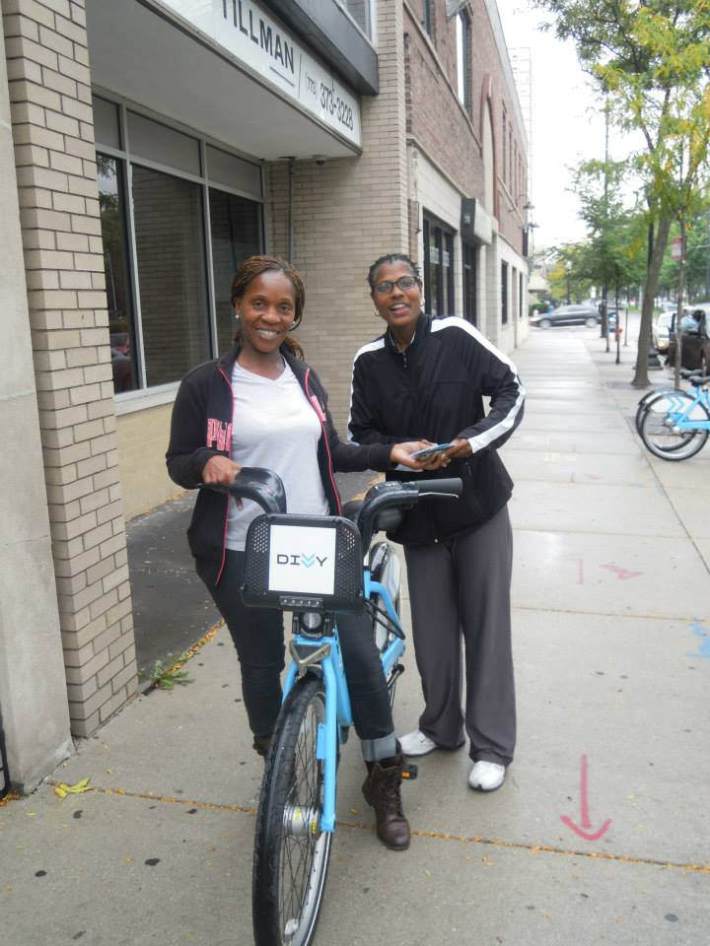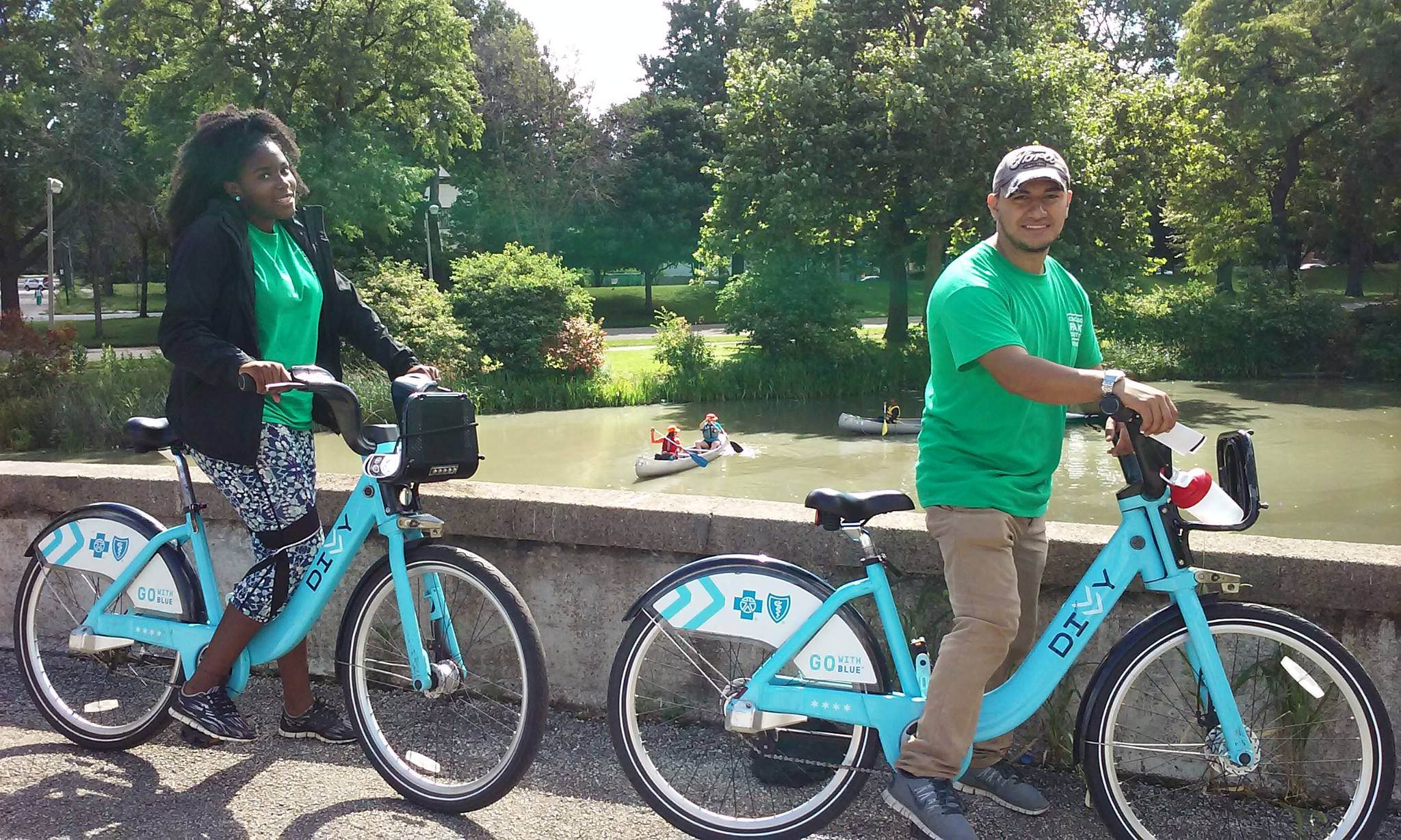[The Chicago Reader publishes a weekly transportation column written by Streetsblog Chicago editor John Greenfield. We syndicate a portion of the column on Streetsblog after it comes out online.]
A taxpayer-subsidized bike-share system that's mostly used by relatively wealthy and well-educated white folks isn't equitable. But that's the situation with Chicago's Divvy network. A 2015 Chicago Department of Transportation questionnaire found that 79 percent of responding members were non-Hispanic whites, most of them had middle to upper incomes, and 93 percent had college degrees. These lopsided numbers are in line with those from bike-share systems in other cities such as Washington, D.C., Boston, and Denver.
To its credit, the city of Chicago has in recent years taken steps to address Divvy's social justice problem. These have included expanding the coverage area to more African-American and Latino communities, and rolling out the Divvy for Everyone (D4E) program, which offers onetime $5 annual memberships to Chicagoans making $35,310 or less a year and waives the usual credit card requirement. More than 2,500 residents have enrolled through the program.
Starting last summer, the city has hosted free adult cycling classes on the south and west sides to further encourage bike-share use. And later this year CDOT plans to add 40 new stations and 400 bikes to the system, with many of the new docks being used to increase station density in lower-income parts of the existing coverage area.
But Divvy still has a long way to go when it comes to providing equal access to diverse residents. That's the conclusion of a new report that looks at the Chicago bike-share system alongside New York's Citi Bike and Philadelphia's Indego networks. The study, titled "Breaking Barriers to Bike Share: Insights From Residents of Traditionally Underserved Neighborhoods," was produced by Portland State University in collaboration with the Better Bike Share Partnership, which provided a $75,000 grant for Divvy for Everyone.
The researchers talked to people in lower-income communities of color, including Bronzeville on Chicago's south side, and identified a number of issues that will need to be addressed if the demographics of bike-share ridership are going to expand. Residents expressed concerns about traffic safety, crime, police harassment, financial barriers, and liability for the bikes. The survey also revealed that many residents in these neighborhoods are unclear about how the systems work, and showed there's a need for more one-on-one outreach regarding the mobility, health, and economic benefits of using bike-share programs.
In all three cities studied, the researchers focused on areas where outreach has been done to spread the word about the local bike-share programs. In Chicago this was the central portion of Bronzeville. Here CDOT has previously contracted Go Bronzeville, a group that was already promoting sustainable transportation in the neighborhood, to tell neighbors about the discounted D4E memberships. Between July 2015 and October 2016 the group reported 36 outreach events, including rides, socials, and tabling at community happenings, reaching more than 1,500 residents. Researchers also surveyed a control group of residents in an area south of Washington Park where there was no Go Bronzeville outreach.
The study found that survey responses from Bronzeville residents were quite similar to those from their counterparts in the predominantly African-American neighborhoods they canvassed in NYC and Philly, which may mean the results are applicable to other towns. In all three cities researchers found that people of color and lower-income residents cited more barriers to using bike-share programs, and cycling in general, than more affluent and white residents. Concern about traffic safety was identified as the biggest obstacle, regardless of race or income—48 percent of the total 1,885 respondents in the three cities cited this as a major issue.
But for people of color, especially lower-income residents, concerns about personal safety are also a significant barrier to using bike-share networks such as Divvy. While only 7 percent of higher-income whites cited fears of being the victim of a crime or an unfair police stop as an obstacle, 17 percent of higher-income people of color and 22 percent of lower-income residents of color expressed these concerns.
About half of lower-income residents of color cited high costs of membership and worries about liability for a lost or damaged bike as a major obstacle. (Presumably in Chicago these respondents were unfamiliar with the $5 D4E membership option.)

Lack of information or misconceptions about how bike-share programs work are also big barriers for this demographic. For 34 percent of lower-income black and Latino residents, not knowing enough about their local network was an obstacle to using it, compared to 19 percent of higher-income respondents of color, and a mere 7 percent of higher-income white residents. Common misconceptions about bike sharing included the notions that helmets are mandatory to use the bikes in these cities, and that credit cards are the only payment option (you can pay for a $5 D4E membership with cash). Surprisingly, 21 percent of respondents thought that the wheels of bike-share cycles will lock up if the rider exceeds the time limit.
Based on survey feedback, the report recommends several strategies for growing bike-share ridership in communities of color, including: discounted memberships (such as D4E), free transfers from bike-share to transit, short-term passes or membership options, free or low-cost helmets and other gear, the option to buy a pass with cash at a store, and organized rides targeted towards particular demographics.
In general, local officials and advocates who've perused a draft of the Portland State study say the new data will help inspire more and better-targeted efforts to bridge the Divvy race and class gap. “Equity is a major concern for the Divvy program,” acknowledged CDOT spokesman Mike Claffey. He noted that many of Chicago’s recent strategies to broaden the system’s rider demographics are in line with the report’s recommendations. Claffey cited a new initiative this year to do additional D4E promotion in South Shore and the neighborhood around the six enrollment center, led by recently hired Divvy outreach workers.
Go Bronzeville leader Ronnie Matthew Harris says the report proves that his group's outreach work is making a difference. "It leaves me elated to find that we haven't been spinning our wheels," he says. The study states that respondents in the outreach area were three times as likely to have gotten information from Go Bronzeville as those in the control area (6 percent versus 2 percent). "However," he says, "the report underscores the challenge to keep going" with the outreach.
Slow Roll Chicago, which promotes biking on the south and west sides, has been contracted by CDOT to do D4E outreach by leading group rides in various parts of the city. "I feel like I'm not reading anything new [in the report], but I'm glad there are people interested in looking more into bike-share equity issues," said Slow Roll member Romina Castillo. "We would love to work together with our bike-share partners and the city to develop programs that will more holistically engage community members and better address their concerns and barriers to active transportation."
"The Portland State University report is further evidence we have a lot more work to do," said the Active Transportation Alliance's Kyle Whitehead. "The report shows traffic safety remains the biggest hurdle in low-income neighborhoods, so building out a more seamless, low-stress, and equitable bike network is one of the best ways to get more people riding."
Bernard Loyd, director of Bronzeville Bikes, a nonprofit that runs a bike shop next to the 51st Street Green Line station, praised the study for providing a wealth of info on the barriers for growing cycling in black neighborhoods. "Unfortunately, Divvy bikes in our neighborhoods mainly sit unused because most residents can't afford them or don't have the required credit card" for checking out a bike at a station or signing up for a membership online. He added that even though cards aren't required for the D4E program, it still has limitations because it requires residents to travel to one of six enrollment centers across the city to sign up.
"Breaking Barriers" is the second report of a larger three-phase research project between Portland State and Better Bike Share Partnership called Evaluating Efforts to Improve the Equity of Bike Share Systems, which also includes an overview, released earlier this month, of how U.S. systems are addressing the diversity issue, and an upcoming study based on surveys of current bike-share users.
The funding for the entire three-part project included $74,986 from BBSP, plus $137,477 in federal transportation research grants. One local African-American bike advocate, who asked not to be named for fear of backlash from the cycling community, argued that this money would've been better spent if it was directly invested in communities of color, rather than being used to pay academics to study them.
Evaluating Efforts coauthor Nathan McNeil defends the project. The $212,463 cost of producing the reports "is only a small fraction of the funds spent to implement the Better Bike Share Partnership efforts, which included grants in each of the study cities to improve bike-share equity in these communities [such as funding for D4E]," McNeil says. "We worked closely with local community organizations in each city throughout the study process, and we hope that the findings can help spur further effective investments in underserved communities."





